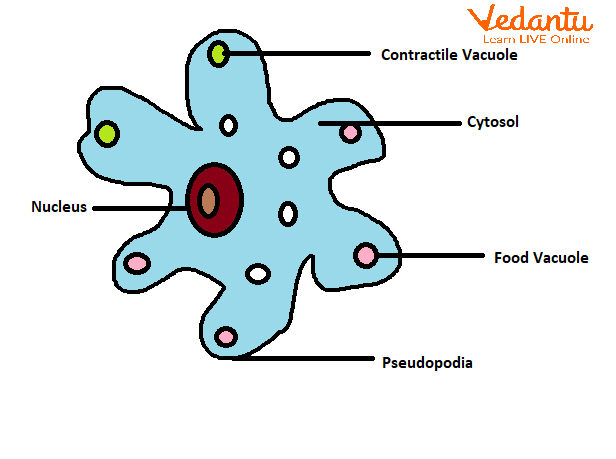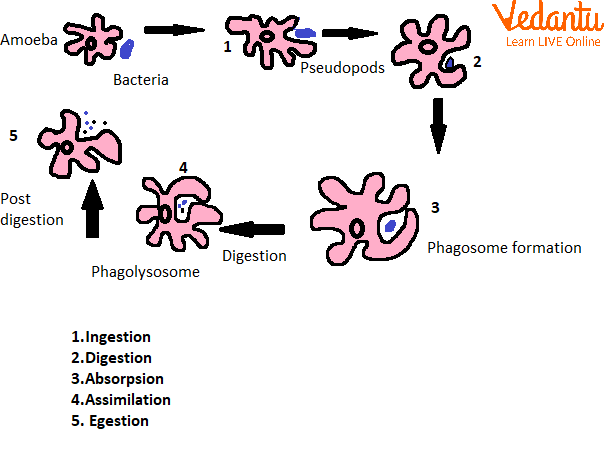What are the main steps in feeding and digestion in amoeba with diagram?
Feeding and Digestion in Amoeba is a fascinating biological process seen in this simple unicellular organism. Understanding how Amoeba captures, digests, absorbs, and utilizes food helps explain not only cell biology but also basic life functions. This topic is important for students and forms a major part of class 12 Biology, as well as for those interested in nutrition and cellular mechanisms.
Feeding and Digestion in Amoeba: Definition & Overview
Feeding and digestion in Amoeba refers to the way this unicellular organism obtains food from its surroundings and processes it to release nutrients. Amoeba shows holozoic nutrition—taking in solid food, digesting it, absorbing nutrients, and ejecting waste. Its flexible and ever-changing shape, caused by its simple cell membrane and cytoplasm, helps it efficiently capture food and carry out intracellular digestion.
How Does Amoeba Obtain and Digest Its Food?
Amoeba mainly feeds on small organisms found in water, such as bacteria and algae. It detects food by movement or chemical signals and reaches towards it by extending finger-like projections known as pseudopodia. The core steps of feeding and digestion in amoeba definition are explained through a sequential process called phagocytosis. This ability places Amoeba among excellent examples of unicellular adaptation.

Modes of Nutrition in Amoeba
Amoeba exhibits heterotrophic nutrition, relying on other organisms for food, unlike plants which are autotrophic. The main mode is holozoic nutrition, which includes:
- Phagocytosis: Engulfing solid particles by flow of cytoplasm.
- Pinocytosis: Absorbing tiny liquid droplets by invagination of the cell membrane.
For a broader understanding, you can read about difference between autotrophs and heterotrophs and nutrition in living organisms.
Process of Nutrition in Amoeba
The feeding and digestion in amoeba diagram explains five key steps, ensuring the cell meets its daily energy needs. It acts as a model to understand digestion in other organisms too.
- Ingestion: Amoeba forms pseudopodia to surround and engulf the food particle, creating a food vacuole.
- Digestion: The food vacuole fuses with lysosomes; digestive enzymes break down food into simpler substances.
- Absorption: Digested nutrients pass from the vacuole into the cytoplasm by diffusion.
- Assimilation: The absorbed nutrients are used for growth, repair, and energy within the cell.
- Egestion: Undigested waste is expelled out by bringing the food vacuole to the cell membrane, which opens to release waste outside.
These steps are important not only for feeding and digestion in amoeba class 12 topics but are also used as basis in teeth and digestion and other multicellular organism studies.
The Role of Pseudopodia in Amoeba Feeding
Pseudopodia are temporary, finger-shaped projections of the cytoplasm. They are the most important structures for both movement and food capture in Amoeba. When sensing food, the amoeba’s membrane flows outward to form pseudopodia around the target. This process, called “phagocytosis,” encloses solid food particles in a food vacuole. Their flexibility is crucial for survival and efficient feeding in constantly changing environments.
Intracellular Digestion: What Happens Inside the Amoeba?
Digestion in amoeba takes place inside the cell. Once a food vacuole forms, enzymes from lysosomes break down the captured food. This process occurs in each vacuole, ensuring the cytoplasm is not harmed by digestive enzymes. Absorbed nutrients are distributed through diffusion. Intracellular digestion is a key difference compared to humans and other multicellular animals, where digestion is extracellular.
Key Features and Adaptations of Amoeba
- No fixed body shape: Amoeba appears like a jelly-like blob, allowing it to move and feed flexibly.
- Single-celled: All life processes—including feeding, digestion, and reproduction—occur within one cell.
- Food vacuole: Acts as a temporary ‘stomach’ for digestion, unlike the digestive tracts in higher animals.
- Engulfs solid and liquid food: Via pseudopodia (for solids) and pinocytosis (for liquids).
- Contractile vacuole: Maintains osmoregulation, preventing the cell from bursting. For more, visit osmoregulation.
Feeding and Digestion in Amoeba: Real-World Relevance
Understanding amoeba’s nutrition has practical applications. For instance, the human immune system uses a similar process called phagocytosis to destroy bacteria. Medical science has found that the concept of food vacuoles inspired innovations in food science and microbiology. Studying amoeba feeding also helps diagnose diseases like amoebic dysentery that affect humans.
Feeding and Digestion in Amoeba: Examples and Short Notes
- **Capturing bacteria**: When amoeba meets a bacterium, it forms pseudopodia around it and engulfs it.
- **Absorbing nutrients**: Amoeba absorbs digested sugar, proteins, and fats directly into its cytoplasm for growth.
- **Ejecting waste**: The cell moves undigested waste to the membrane and expels it easily—this keeps the cell clean and healthy.
These instances in feeding and digestion in amoeba examples give insight into how unicellular life solves challenges we see at larger scales in complex animals and humans.
Interesting Facts about Amoeba
- Flexibility: Amoeba can change shape to escape predators or move toward food.
- Multipurpose organelles: All life functions—movement, digestion, even reproduction—occur in one cell.
- Medical link: Some amoeba species cause diseases; studying their feeding helps in medicine.
Comparison: Digestion in Amoeba vs. Human Beings
| Aspect | Amoeba | Humans |
|---|---|---|
| Type of Digestion | Intracellular (inside food vacuoles) | Extracellular (in digestive tract) |
| Specialized Organs | No, all in one cell | Yes, multiple organs |
| Food Capture | Pseudopodia, endocytosis | Mouth, teeth, hands |
| Waste Removal | Direct through cell membrane | Via anus after digestion |
This table summarizes the main differences between feeding and digestion in amoeba and in complex animals like humans. Each method suits the organism’s structure and lifestyle.
Feeding and Digestion in Amoeba: MCQs for Practice
- Which organelle performs digestion in Amoeba? (A) Food vacuole (B) Nucleus (C) Mitochondria (D) Ribosome
- What is the process called when Amoeba engulfs solid food? (A) Diffusion (B) Phagocytosis (C) Pinocytosis (D) Active transport
- How does Amoeba expel undigested food? (A) Through cilia (B) By exocytosis at the cell membrane (C) Using the nucleus (D) Flagella
You can find more feeding and digestion in amoeba questions in Vedantu’s Biology MCQ section.
Feeding and Digestion in Amoeba: Diagram
A well-labelled feeding and digestion in amoeba diagram shows pseudopodia, nucleus, contractile vacuole, food vacuole, and cytoplasm. It’s a valuable tool for study and exam preparation. For more visual learning, explore Amoeba diagrams and other biology diagrams at Vedantu.

Further Reading and Related Biology Topics
To expand your knowledge on feeding and digestion, check out these related concepts:
- Cell Theory and Unicellular Life
- Teeth and Digestion in Animals
- Animal Adaptations
- Life Processes in Biology
- Nutrient Functions for Growth and Health
Feeding and digestion in Amoeba is a well-studied, classic model for understanding nutrition and cell biology. This page described its definition, main steps, special features, and real-world applications. Use these insights for your next exam, project, or to appreciate life’s complexity—even in the tiniest cells.


FAQs on How feeding and digestion in amoeba works: process, steps, and key features
1. What is feeding and digestion in Amoeba?
Feeding and digestion in Amoeba involve the process by which the organism captures food and breaks it down for absorption.
- Amoeba uses pseudopodia (false feet) to surround and engulf food particles through a process called phagocytosis.
- The engulfed food forms a food vacuole inside the cytoplasm.
- Enzymes from the cytoplasm enter the food vacuole and digest the food.
- Digested nutrients are absorbed, while undigested residue is expelled out of the body.
2. Describe the process of nutrition in Amoeba step by step.
Nutrition in Amoeba occurs through a sequence of clear steps:
- Ingestion: Amoeba forms pseudopodia to capture food particles.
- Formation of Food Vacuole: The food is enclosed within the cell, forming a food vacuole.
- Digestion: Enzymes are secreted into the vacuole to break down complex food substances.
- Absorption: The digested nutrients are absorbed into the cytoplasm.
- Assimilation: Nutrients are used for growth, energy, and repair.
- Egestion: Undigested waste is expelled through the cell membrane.
3. How does Amoeba obtain its food?
Amoeba obtains its food by using pseudopodia to engulf particles from its surroundings.
- It extends its cell membrane to form pseudopodia around the food item.
- The food is trapped and enclosed in a food vacuole.
- This method is called phagocytosis or 'cell eating'.
4. What is phagocytosis in Amoeba?
Phagocytosis in Amoeba is the process of engulfing solid food particles.
- The cell membrane extends out as pseudopodia surrounding the food.
- The food is enclosed, forming a food vacuole.
- Phagocytosis is essential for ingestion and is the first step in the nutrition process of Amoeba.
5. Explain the role of pseudopodia in the feeding process of Amoeba.
Pseudopodia play a crucial role in the feeding process of Amoeba.
- They are temporary projections of the cell cytoplasm.
- They help Amoeba to move and capture food by flowing around the particle.
- Pseudopodia enclose the food, helping to form a food vacuole where digestion occurs.
6. What happens to the food after it enters the Amoeba?
After food enters the Amoeba, it is processed inside a food vacuole.
- Digestive enzymes are released into the vacuole.
- The food is broken down into simpler substances.
- The nutrients are absorbed into the cytoplasm for energy and growth.
- Undigested remains are expelled out by the cell membrane.
7. Mention the difference between digestion in Amoeba and human beings.
Digestion in Amoeba is different from that in human beings in several ways:
- Amoeba digests food within a single cell using food vacuoles.
- Humans have a complex digestive system involving many organs.
- In Amoeba, digestion is intracellular; in humans, it is extracellular (in digestive tract).
- Amoeba obtains food by phagocytosis; humans use mouth and alimentary canal.
8. What happens to undigested food in Amoeba?
Undigested food in Amoeba is eliminated by the process of egestion.
- After digestion, leftover material collects near the cell membrane.
- The vacuole merges with the membrane, expelling waste out of the body.
9. Can you explain the importance of food vacuole in Amoeba?
The food vacuole is essential for digestion in Amoeba.
- It acts as a temporary chamber for breaking down engulfed food.
- Enzymes are secreted into the vacuole to digest the material.
- Absorption of nutrients takes place from the vacuole into the cytoplasm.
10. How is amoeboid movement helpful in nutrition?
Amoeboid movement helps Amoeba to capture food and reach nutrient-rich areas.
- Pseudopodia enable Amoeba to change shape and move towards food particles.
- This movement increases chances of finding and engulfing food efficiently.










